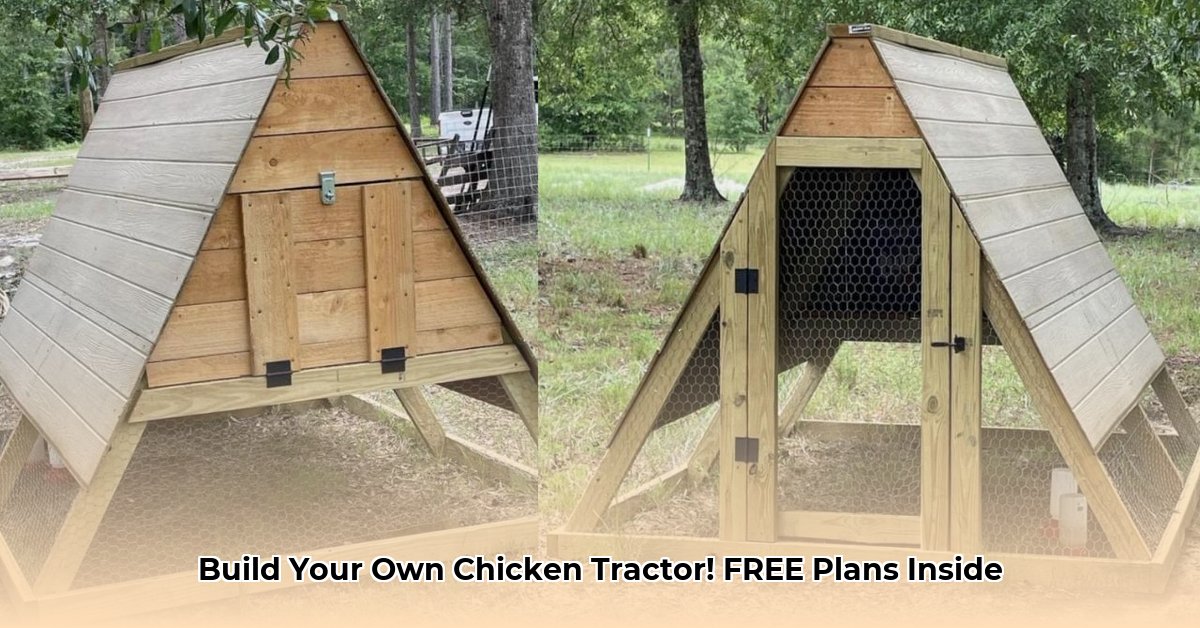
Want fresh, farm-fresh eggs and happy, healthy chickens? Building your own A-frame chicken tractor is a rewarding project that's surprisingly easy and cost-effective! This comprehensive guide provides two free plans, comparing their strengths and weaknesses to help you choose the perfect design for your skills and budget. We'll walk you through each step, ensuring a successful build, no matter your experience level. Let's get started! For additional resources, check out this helpful site: Chicken Coop Plans.
Two A-Frame Chicken Tractor Plans: A Detailed Comparison
This guide offers two distinct A-frame chicken tractor plans, catering to varying skill levels and budgets. Choosing the right plan depends heavily on your experience, available resources, and local predator concerns. Aren't you excited to build the perfect home for your feathered friends?
Plan 1: The "Fortress" – Maximum Durability
This plan prioritizes robust construction for long-term use and superior predator protection. While the initial investment is higher, the "Fortress" design promises years of reliable service, minimizing long-term costs. Did you know that a well-built chicken tractor can increase egg production by up to 15%?
Materials List:
- Galvanized steel (for the frame) – offers superior strength and rust resistance
- Pressure-treated lumber (for the floor and roof) – essential for longevity and moisture resistance
- Heavy-duty wire mesh (for the sides) – choose a gauge appropriate for your local predators
- Heavy-duty wheels – ensure smooth movement across various terrains
- Hinges, screws, fasteners – select high-quality components for lasting durability
Step-by-Step Building Guide:
- Frame Construction: Begin by assembling the A-frame using the galvanized steel. Welding skills are highly recommended for this stage. If you lack welding experience, seek assistance from a qualified welder.
- Mesh Enclosure: Securely attach the heavy-duty wire mesh to the steel frame, ensuring a tight fit to prevent escapes and predator intrusions. Consider using zip ties or wire fasteners for additional security.
- Floor and Roof: Build the pressure-treated lumber floor and roof. The roof should be hinged for easy access to clean the coop. A removable roof simplifies cleaning and maintenance.
- Wheel Installation: Attach the heavy-duty wheels to the frame for easy mobility. Consider adding a locking mechanism to prevent unwanted movement.
- Door/Ramp Installation: Construct and install a secure hinged door or ramp for easy chicken access. A ramp minimizes stress on your hens when entering and exiting the coop.
- Interior Fixtures: Add nesting boxes and roosting bars to provide a comfortable living space for your chickens. Use comfortable, easy-to-clean materials.
Estimated Time and Cost: Expect approximately 20-24 hours of labor. The material costs range from $300 to $500, depending on material pricing and your location. Remember to factor in the cost of any necessary professional assistance (welding).
Pros and Cons:
| Pros | Cons |
|---|---|
| Extremely durable and long-lasting | Requires welding skills, higher initial cost |
| Superior predator protection | More complex build |
| Easy to move |
Plan 2: The "Quick & Easy" – Beginner-Friendly Design
This plan prioritizes speed and simplicity, making it perfect for beginners or those on a tighter budget. While not as durable as the "Fortress," it's a great option for quickly establishing a functional chicken tractor. Did you know that even a basic chicken tractor can significantly reduce the spread of parasites and diseases?
Materials List:
- Untreated lumber (for the frame) – Choose a rot-resistant wood type if possible.
- Chicken wire (for the sides) – Ensure the mesh is fine enough to prevent small predator entry.
- Simple hinges and latches
- Basic wheels (optional)
Step-by-Step Building Guide:
- Frame Assembly: Cut and assemble the A-frame using basic carpentry techniques.
- Wire Mesh Attachment: Attach the chicken wire securely to the frame using staples or wire. Ensure no gaps or weak spots to prevent chicken escapes.
- Floor Construction: Build a simple wooden floor.
- Roof Construction: Create a simple sloped roof to provide shelter from rain. A simple tarp can also work as a temporary solution.
- Interior Features: Add simple nesting boxes and roosting bars. Keep the interior simple and easy to clean.
Estimated Time and Cost: This project typically takes 10-12 hours to complete, with material costs ranging between $150 and $250. Consider using recycled materials to further reduce expenses.
Pros and Cons:
| Pros | Cons |
|---|---|
| Budget-friendly and easy to build | Less durable, potentially shorter lifespan |
| Requires minimal tools and skills | Might require more frequent maintenance |
| Quick construction time | May require reinforcement depending on location and predators |
Comparing the Plans: A Side-by-Side Analysis
| Feature | Fortress | Quick & Easy |
|---|---|---|
| Primary Material | Galvanized steel, treated lumber | Untreated lumber, chicken wire |
| Build Time | 20-24 hours | 10-12 hours |
| Estimated Cost | $300-$500 | $150-$250 |
| Durability | High | Moderate |
| Skill Level | Intermediate to Advanced | Beginner |
| Mobility | Excellent | Good |
Selecting the Right Plan for Your Needs
Before you start, consider these vital questions:
- Budget: How much can you comfortably spend?
- Skill Level: Are you comfortable with basic carpentry or welding?
- Predator Risks: What predators are prevalent in your area? A stronger design is vital in areas with significant predator pressure.
- Climate: How extreme is your local weather? A sturdier coop may be necessary in harsh climates.
Beyond the Plans: Important Considerations
- Local Regulations: Check for any building permits or regulations in your area before construction.
- Maintenance: Regular cleaning and inspections are necessary to maintain your chicken tractor. "Prevention is better than cure," as the saying goes.
- Expansion: Plan for future growth. Your flock might grow, and you'll want to adjust your chicken tractor accordingly.
Remember to prioritize safety and longevity when building your A-frame chicken tractor. With careful planning and execution, you'll provide your hens with a comfortable and safe home for years to come. Happy building!